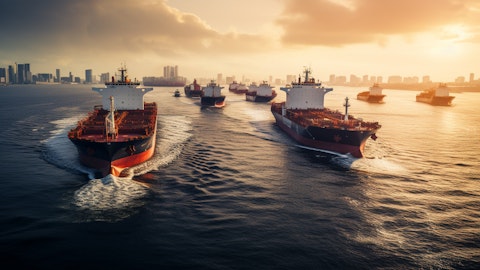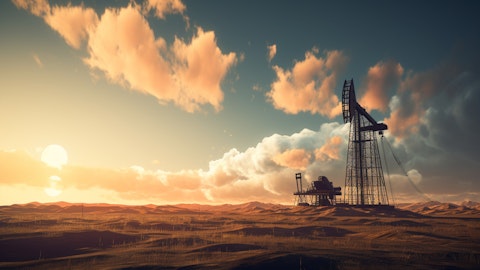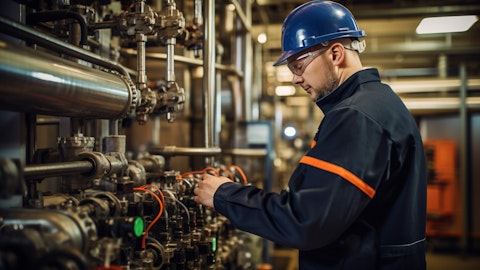Keith Chiasson: Manav, I think we talked a little bit about our focus on reliability. And with improved reliability, you do see two things. Obviously, your denominator increases with higher throughput but also your unplanned unscheduled and reactive maintenance goes down. So, those two things we do think will help us start moving to the range that you’ve alluded to. We made big steps between 2023 and 2024 to get there. We do have to do some of this maintenance activity in the turnaround cycles in order to drive that further improvement in reliability, but that is our focus that, coupled with improving margin capture and the commercial profitability of the asset. So, we are focused on that. We have plans and the plans are underway and starting to show fruition. So, pretty excited.
Manav Gupta: Thank you.
Operator: Thank you. [Operator Instructions] Your next question comes from the line of Neil Mehta from Goldman Sachs. Please going ahead.
Nicolette Slusser: Hi, good morning and thanks for taking the time. This is Nicolette Slusser on for Neil Mehta. So, just the first question on the Upstream. I wanted to ask about some of the growth and optimization projects. in the business. Can you just talk about the factors underway this year for Christina Lake? And then as well the Foster Creek optimization and factors over the next few years, we should be on the lookout for ahead of that fully arranged production by the end of 2027.
Keith Chiasson: Yes, thanks for the question. Maybe I’ll just step back to our Investor Day where we laid out plans for upstream growth of about 150,000 barrels a day over the next three to four years. So, narrowing in specifically on Christina Lake, the 20,000 to 25,000 barrels a day comes from tying in our Narrows Lake resource back into the Christina Lake asset. And to do that, we’re going to be putting in new pads, which are well underway and putting in a pipeline that ties that resource back. And that pipeline is nearing mechanical completion by the year — by end of this year, we should be hydro testing the line and putting it into service early next year, which will allow us to bring steam up to that resource and start steaming those pads for the production that will come on in the back end of 2025.
So, things are progressing as expected, on plan and on schedule. With regards to Foster Creek, it’s a little later in time in the fact that both projects, the Foster Creek debottleneck, which will add steam capacity to foster is scheduled to come on in the mid-2026 timeframe. In addition, we’re also adding a naming close unit to that asset, which will help drive down our unit OpEx almost CAD0.75 a barrel. So, those projects are progressing well. They’re underway. A lot of activity will happen through this year in 2025 for startup in 2026. Sunrise is another growth opportunity for us. We have our first new pad since 2020 online and producing. We have a couple of additional pads coming on stream at the back end of the year. That really sustains our production.
And then we have new pads coming on in 2025 as well that allows us to start growing production. The steam capacity is there. It’s a matter of fully utilizing our capacity to generate that incremental 20,000 barrels a day of production. And then on the East Coast, we have our West White Rose project. So, the SeaRose is off station going through its asset life extension, expect that back in the July time period and West White Rose project, we finished our last pour on the gravity-based structure in the first quarter. So, that part of the project is complete. We’re working towards mechanical completion and commissioning on the top side. All that gets made it up in 2025, and we commenced drilling and start seeing production in 2026, ramping to peak production, 45,000 barrels a day in 2028.
So, all those projects are progressing well. And then I guess the last one I would talk about is our conventional heavy oil, where we’ve ramped up our rig activity and our drilling incremental wells and are starting to see the fruits of that labor with production growing from current base of around 20,000 barrels a day up to 40,000 barrels a day over the next two to three years.
Nicolette Slusser: Okay, great. Very helpful context. Thank you. And then a quick follow-up is just on offshore. So, I understand from the release that production from White Rose and the Terranova fields is stored at a terminal prior to shipment which can then result in a timing difference between production and sales. So, just wondering if there’s any additional commentary on this phenomenon and how we should expect the phasing of the sales timing impacts as White Rose and Terra Nova production in flex?
Jon McKenzie: Yes, I don’t know that there’s anything magical in that what we what can happen when you have relatively low levels of production like we did in the first quarter with the SeaRose being off-station and production at Terra Nova averaging about 7,000 barrels a day is the difference between the timing the oil is produced and moved to if and had before, it’s ultimately sold. So, you do need to put yourself in a position where you built enough volume for a cargo and once you sell that cargo, you realize, obviously, the funds from it. So, it’s just a timing difference. It’s nothing that’s unique. But as we get more and more production on the East Coast with the West White Rose project coming on, that will become increasingly more ratable through time. But it’s just a timing difference, and there’s really nothing to see there.
Nicolette Slusser: Okay, very clear. Thanks so much.
Operator: Thank you. And your next question comes from the line of Dennis Fong from CIBC. Please go ahead.
Dennis Fong: Sorry, apologies for greedily getting back in the question queue. Keep us answering the previous question there at Sunrise. I was just hoping for a little bit more clarification there. With the 2025 well, is that enough to fully utilize like the 50,000 to 60,000 barrels a day of excess steam capacity at the facility? Or are there other kind of optimizations that you can do to improve production potentially beyond the 20,000 barrels a day?
Keith Chiasson: Hey Dennis, yes, thanks for the question. Right now, we’re focused on kind of fully utilizing the steam capacity and installed capacity is around 210,000 barrels a day of steam capacity, and we’re currently using kind of 160,000. So that’s where that incremental production comes from. But we are actually using the new Cenovus techniques as we put in these wells and we will evaluate kind of the SOR performance on utilizing that technique over time. And there is a potential that we could start seeing even more improved SOR relative to historical performance. And if that happens, then there might be some upside potential. But at this point, what’s built into our numbers is really just fully utilizing the installed capacity and using that on the new wells that we’re putting into place.
Dennis Fong: Great. And then on Lloyd, I appreciate the comments at the very beginning there, Jon. talking about stronger pump utilization and uptime there. I’m just curious as to how sustainable you view this current level of production. Obviously, there’s a good uptick on a quarter-over-quarter basis. I know there’s kind of a focus on reaching further from central processing facilities, accessing kind of new areas of reservoir. I just wanted to see what maybe the production level could be on a go-forward basis from Lloyd.
Jon McKenzie: Yes, I’m not going to write a check on Keith’s behalf. He’s looking at — what I would tell you is this is Lloyd is a different reservoir than what we have at Foster and Christina. And over the last three years, we’ve learned a lot about producing at Lloydminster. And we continue to find opportunities to grow production at Lloyd. So, I think we’ve taken a relatively conservative view sort of a P50 view as you — if you will, as that where we think that production is going to be. It’s currently producing at a rate that would be higher than where we would have budgeted this year, but it’s been there for some period of time. And the subsurface people, together with the operating people just continue to find opportunities to debottleneck to drill wells differently to operate the reservoirs differently, and it continues just kind of to surprise to the upside.
So, I wouldn’t want to be in a position where I’d be telling you this is going to outperform the way it has. Over the course of the last few quarters. But what I would say is we just continue to find opportunities here that provide that kind of upside for us.
Dennis Fong: Great. Appreciate the color. I’ll turn it back.
Jon McKenzie: Thanks Dennis.
Operator: Thank you. And our last question comes from the line of Chris Varcoe from Calgary Herald. Please go ahead.
Chris Varcoe: Hi. A question for Jon. Jon, just talking about Trans Mountain. Given that it took 13 years to get that project from its inception to completion, what does that tell you about Canada’s ability to get major energy projects built like the pathways development?
Jon McKenzie: What I would say, Chris, first of all, is that I think Drew mentioned this, and I wouldn’t want to taint today with a discussion about the difficulty of getting projects built because this is a great day for Canada to get this pipeline up and running, get it producing, and the people of Canada are going to see the benefit for a long period of time in terms of increased taxes and royalties and the like. I think as a nation we suffer, and I don’t think I’m saying anything that people don’t already know from lower and decreasing productivity, and we need to find ways to get major projects built to get infrastructure built to the benefit of all Canadians. And I think we would all realize that 13 years is far too long for a project of this national importance to get built. And I think that’s something that everybody understands.
Chris Varcoe: Given your own company’s expectations for growth and other growth estimates out of the Western Canadian Basin, do you think Western Canada is going to need more pipeline capacity? And when do you think that might be — or given the challenges that you just talked about, do you think this is the last export pipeline of a major size that gets built?
Jon McKenzie: Yes, I think as an industry, we have a history of filling up excess egress, and I think that will happen through time. I’ve seen various estimates of when that’s going to happen. Some suggest within two years, others within five. I think we would be closer to the upper range of that in terms of our thinking. It is increasingly difficult to build pipelines in this country, and it wouldn’t surprise me if this was the last pipeline. But the reality is we have a tremendous resource here in Canada and we produce our oil in my view, more sustainably than probably anywhere else in the world. And if we were in a position where as a nation, we decided to take that to market, we should be building more pipelines.
Chris Varcoe: Thank you.
Jon McKenzie: Thanks Chris.
Operator: Thank you. That concludes our question-and-answer session. I’d like to turn the conference back to Mr. Jon McKenzie for closing remarks.
Jon McKenzie: Yes. Listen, thank you very much for your interest in the company today on behalf of the management team, the Board of Directors and the staff here at Cenovus, we really appreciate your interest and support in the company. So, have a terrific day and thank you again.
Operator: Thank you. That concludes our conference for today. Thank you all for participating. You may all disconnect.
Follow Cenovus Energy Inc (NYSE:CVE)
Follow Cenovus Energy Inc (NYSE:CVE)
Receive real-time insider trading and news alerts





